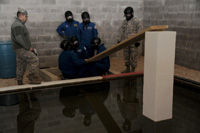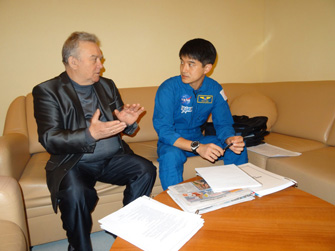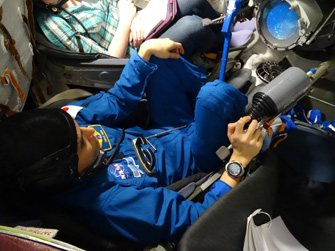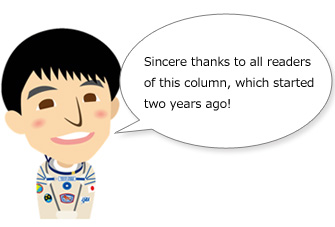JAXA Astronaut Activity Report, March, 2014
Last Updated: May 27, 2014
This is JAXA’s Japanese astronaut activity report for March 2014 and concludes the “New Astronauts at the Front Line” series. Thank you for reading and supporting these articles over the past two years.
The three astronauts, Yui, Onishi, and Kanai graduate as “rookies” and further progress as astronauts.
Long-term ISS mission training of astronaut Kimiya Yui
Astronaut Kimiya Yui, who was assigned as a crew member for the Expedition 44/45 mission to the International Space Station (ISS), underwent various training programs for a long-duration mission at the NASA Johnson Space Center (JSC).
During Extravehicular Activity (EVA) training, Yui confirmed the procedures performed by the EVA crew before commencing EVA.
Yui confirmed the procedure of excreting nitrogen from the human body to prevent decompression sickness (bends) during EVA performed under low atmospheric pressure.
In addition, he learned the duties of a Crew Medical Officer (CMO) to be performed on orbit, including medical checkups, first-aid procedures, and how to use medical devices.
Yui learned how to use medical hardware for medical experiments and checkups, including ultrasound devices to measure muscle mass, devices to examine eyes, and a Space Linear Acceleration Mass Measurement Device (SLAMMD), which measures body mass using acceleration.
Regarding ISS experiments, Yui learned about NASA’s research that studies how meal menus and environments affect astronauts’ stress and the team atmosphere as well as the European Space Agency’s (ESA) plant experiment equipment.
Yui will continue training for his ISS long-duration mission, which is scheduled to start from June 2015.Yui has his own Twitter account and is tweeting details of his training and recent events. See his tweets at https://twitter.com/Astro_Kimiya
Long-duration ISS mission training of astronaut Takuya Onishi
Continuing from February, Astronaut Takuya Onishi, a crew member for the ISS Expedition 48/49 mission, trained at the Gagarin Cosmonaut Training Center (GCTC) in early March and then at the NASA Johnson Space Center (JSC) in the last half of the month.
At the GCTC, Onishi was trained in the Thermal Control System, Communication and Tracking Systems, Combined Propulsion System, and Power Supply System of the Soyuz spacecraft. Onishi was lectured about each system, practiced using a simulator and took an exam to confirm the acquired knowledge.
At the JSC, he acquired wide-ranging knowledge and techniques on ISS operations, including the ISS Electrical Power System, water usage and management, ISS in-flight maintenance tools, an overview of the onboard maintenance tasks, and Space Station Remote Manipulator System (SSRMS) operations for visiting supply vehicles.
Onishi will continue training for his ISS long-duration mission, which is scheduled to start from June 2016.
Astronaut Norishige Kanai participates in leadership training at the U.S. Maxwell Air Force Base

Part of the training session (Credit: U.S. Air Force photo/Staff Sgt. Gregory Brook)
From March 3-5, astronaut Norishige Kanai, alongside some other NASA and Canadian astronauts, participated in leadership training held at the Maxwell Air Force Base in Alabama, U.S.
This training was developed under cooperation between NASA and the U.S. Air Force, and was intended to foster leadership and teamwork through team activities; targeting a goal under various physical and mental burdens imposed.
With restricted time and communication, Kanai and the other participants tackled various tasks.
New Astronauts at the Front Line

Thank you again for reading the Diary of a Space Turtle, although I am sorry that today marks the last of our reports on New Astronauts at the front line.
In Japan, March and April are months of graduation and enrollment, particularly for young people. Like the other two, I will do my utmost to earn recognition as a professional astronaut, dismissing excessive dependence of newcomers. I initially wanted to choose an appropriate theme for my last Diary, but failed to find a suitable topic in time. In fact, I rewrote my manuscript for the last Diary three or four times; hesitating to select a single theme. Concluding a serial column is a really tough task!
Let me ask you a question: Are you now interested in space development? I suppose that you, as readers of my own reports and those of other newcomers, have at least some interest in that field. I ask you this question because it is pleasing if our messages have helped give you an insight into space development and further encouraged you to willingly provide support of any kind for our activities and reflects the success of our column. As newcomers of space development, we were very delighted when we received a proposal to write this serial column to further publicize our training and other activities. We have sent you twenty-one reports, or twenty-eight if the “Sea Turtle” column during the NASA Extreme Environment Mission Operation (NEEMO) is included. Personally, I am not confident whether my reports will arouse much interest among readers, but would still like to thank all of you for having assisted all three of us in many ways. I hope you will forgive my inability to express what I wanted to say in writing. We feel obliged to express special thanks to those having sent us specific opinions and impressions over these two years, which really encouraged us!
While working on this column, I found myself becoming increasingly impressed by the influence of language. Moreover, during my professional activities as an astronaut, I hope I will be able to optimally exploit language to help others show their potential and contribute to mutual understanding, encouragement and cooperation among various foreign nationals, in a word, for a better Universe.
Talking of language, visitors to my Twitter page may already be aware of the delight I take in learning Russian, knowing the meanings of Russian terms and expressions and even finding opportunities to use them. To exploit elegant expressions in the foreign language to make myself well understood is to feel the counterpart’s soul “twinkle.” What a wonderful power language has!
However, language also has a negative side. If used wrongly, it may harm people, provoke disputes or fights, or even kill people. In our daily life, we should carefully reconsider things before talking, namely how our words will impact on and affect those hearing them. This is what I strive to do on a daily basis. All of us have experienced anger at some time. Under such circumstances, we should be careful what we say. One of the measures I take to guard against such negative feelings is to first cool down, record my honest thoughts and ideas and sleep on it. The following day, I often find the thoughts and ideas I wrote down do not reflect my actual thoughts, since I feel my anger easing and start to feel my “self” entitlement to analyze my previous day’s anger. This is precisely the time I think I have yet to mature and that it was a good choice not to have let out my anger at other people. Before discussion, it is important to be more rational and logical and consider other parties. This is the technique I use to cope with anger, but everyone may learn a lesson from it.
Well, let me now discuss my future communication with the public. Following this New Astronauts at the front line column, my plan is to continue the Diary of a Space Turtle in a different form, although it is subject to the approval of the appropriate directors. Please wait a while. I will welcome your advice and frank opinions about my future communication with you and once made, I will announce any decision via my Twitter page. See you!

My training is also underway this month, in Star City (Russian: Zvyozdny Gorodok) in Russia.
In previous training sessions, I learned about the communication system, electrical power system and heat control system of the Soyuz spacecraft. Now, the new training theme for this month’s sessions concerns the motion control system and as was outlined in the previous Courier, this may be the key training period for the Soyuz spacecraft.
In short, the motion control system is technology used to control how spacecraft are positioned and moved within a three-dimensional space. It is crucial for guiding the spacecraft released from the rocket up to the altitude of the International Space Station (ISS), docking it with the ISS, separating it from the ISS once six months of a mission have elapsed, and guiding it back into the aerosphere.
The positional control in space is not a simple portion of all the motion control system tasks. On Earth, each one of us easily recognizes his/her corporal position or upright, tilted or inverted attitude. Gravity is a great benchmark for recognizing our body positions. However, despite being “common knowledge”, other rules apply in space.
Humans in space have no idea of verticality or upward and downward direction. The first thing to do in space for positional recognition is to determine your own attitude in relation to Earth. Once this basic recognition is obtained, you can compute the required operations for placing a spacecraft in the desired positions, although this is not discussed in aircraft sciences known to me before my spacecraft career. Learning about spacecraft is all the more interesting for its particularities and difficulties.
April 11, 2014 marked the day when the initial motion control system tests were successfully completed. Mr. Viktor Suvorov was responsible for the training sessions to date and has worked in the Yuri A. Gagarin State Scientific Research-and-Testing Cosmonaut Training Centre (GCTC) for forty-five years! Indeed, I was not even alive in the initial years of his career. He has witnessed almost all periods in the great history of the Soyuz spacecraft, which commenced in 1967, and resembles Master Yoda, a character in the film “Star Wars.”
The systems installed on the Soyuz spacecraft are supported by various kinds of backup devices; most of which were developed against a historical background of actual failures. In response to my question as to why certain mechanisms were arranged in a specific manner, instructor Suvorov once started to explain a whole episode of the history: “It was on the Soyuz ****, *** years ago that ...” I delighted in such talks.
Moreover, while most NASA instructors are relatively young, Star City attracts such veteran experts as Mr. Suvorov. Does this difference between the Russian and U.S. spacecraft development organizations tell us something?

“Master Yoda” briefing me before a training mission using a mockup (source: JAXA/GCTC)

Me manually controlling the mockup positions (source: JAXA/GCTC)
This column “New Astronauts at the front line” kicked off with the April 2012 issue of the JAXA Astronaut Activity Report. Two years have since elapsed, during which I experienced many things. I suppose my readers have also experienced many things in life. At the turning point of two fiscal terms, the three of us discussed this column and concluded that we would put an end to the current public communication channel.
This project was intended for JAXA astronauts to directly communicate with the public. Personally, I have set out three objectives for it: discussing various topics, presenting the extremely professional world of astronauts in common and plain language to make it more publicly accessible, and exposing my “life-sized” ideas and impressions. These objectives proved difficult to achieve while continuing the column, particularly the second. Long committed to a world in which extremely professional terms are used, insiders are often incapable of distinguishing technical jargon from common terms. If a columnist chooses to write all things in plain language, the “ambiance” of the astronautic world may be lost. I tried to be most careful about balancing the two extremes. Have I been successful, readers?
Our future style of communication with the public will be discussed with the relevant persons from the public relations department and personally, I see scope to use some social networking service (SNS).
I have read all the opinions and comments sent by readers. We will optimally exploit this precious information and resume communication with you very soon.







